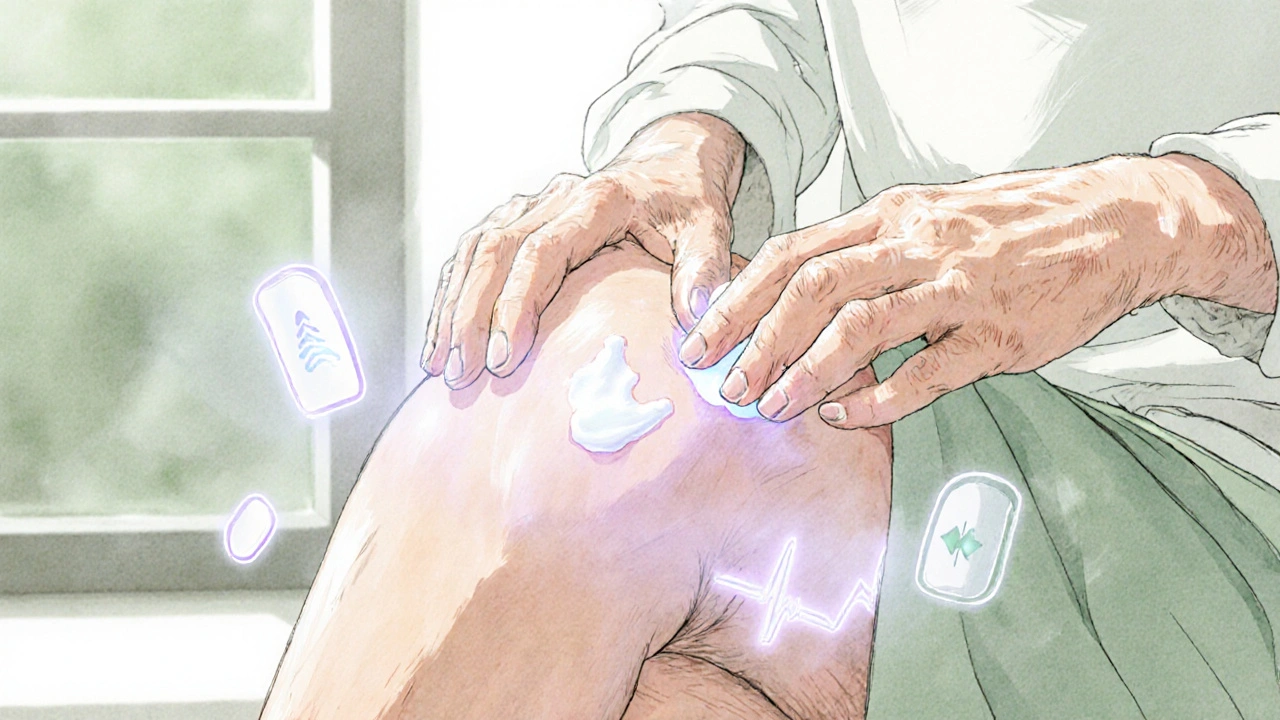Medication Delivery Route Comparison Tool
Your Condition
Your Age Group
Your Primary Concern
Your Personalized Recommendation
Oral Medications
Best for systemic conditions like blood pressure or depression. Avoid if you have stomach issues.
Injections
Only for critical emergencies or when oral/topical won't work. Consider if you need fast-acting medication.
Topical Medications
Ideal for localized issues like joint pain or skin rashes. Minimizes systemic side effects by 87% for seniors.
Your Recommended Route:
Select options to see your recommendation
Based on article research about delivery route side effects
How Your Medicine Gets Into Your Body Changes Everything
You take a pill for your headache. Your doctor gives you a shot for a severe infection. Your partner rubs a cream on their sore knee. All three are medicines - but they work in completely different ways. And the way they enter your body doesn’t just change how fast they work. It changes what side effects you get, how often, and how serious they are.
Most people think a drug is a drug. If it’s ibuprofen, it’s ibuprofen - whether it’s a pill, a shot, or a gel. But that’s not true. The route of administration isn’t just a delivery method. It’s a switch that turns on or off entire chains of side effects. And knowing which route you’re on can help you avoid unnecessary risks, save money, and feel better faster.
Oral Medications: Convenient, But Hard on Your Gut
Over 75% of all prescriptions are taken by mouth. It’s easy. No needles. No mess. You just swallow it with water. But that convenience comes with a price.
When you swallow a pill, it travels through your stomach and intestines. Then it gets sucked into your bloodstream - but not before passing through your liver. That’s called first-pass metabolism. Your liver breaks down part of the drug before it even gets to work. That’s why you need a higher dose orally than you would if the same drug were injected. Propranolol? Only 25% of the pill you swallow actually makes it into your system. Penicillin V? Just 15-30%.
That means you’re taking more of the drug to get the same effect. And more drug = more chances for side effects. The most common? Stomach upset. Nausea. Diarrhea. Heartburn. For people on long-term NSAIDs like ibuprofen or naproxen, 1-2% develop stomach ulcers. That’s not rare - that’s common enough for doctors to prescribe acid-reducing pills alongside them.
And it’s not just your stomach. Food changes everything. Grapefruit juice can make some blood pressure pills 3x stronger. Calcium in dairy can block antibiotics like tetracycline. 40% of common medications have known food interactions. If you’re not careful, you might be taking the right drug - but the wrong dose.
Injections: Fast, Precise, But Risky
Needles scare people. That’s normal. But injections aren’t just for hospitals. Insulin, vaccines, biologics for arthritis - they’re all injected. And they’re used for a reason: speed and control.
When you get a shot into a vein (IV), the drug hits your bloodstream instantly. Peak effect? 2-5 minutes. No waiting. No guesswork. That’s why emergency meds like epinephrine for allergic reactions are given by injection. Oral epinephrine? It wouldn’t work fast enough to save a life.
Intramuscular (IM) and subcutaneous (SC) shots are slower but still faster than pills. IM hits peak levels in 45-60 minutes. SC takes 60-90 minutes. But here’s the kicker: nearly 100% of the drug enters your system. No liver breakdown. No stomach acid. No food interference. That’s why insulin works so well as a shot - it’s designed to mimic how your body naturally releases it.
But that power comes with risk. Injection sites can get infected. Swelling. Redness. Pain. Around 15-20% of IM injections cause local reactions. And if you’re giving yourself shots daily - like with insulin or rheumatoid arthritis drugs - you might develop lumps under the skin called lipohypertrophy. That’s when fat builds up from repeated injections in the same spot. It messes with absorption and makes dosing unpredictable.
Then there’s cost. A monthly insulin shot might cost $75 if it’s oral. But the injectable version? $450. And that’s not even counting the needles, alcohol swabs, or sharps containers. For many, that’s a barrier to treatment.

Topical: Localized Relief, Fewer Systemic Side Effects
Think of topical as the quiet performer. Creams, gels, patches - they sit on your skin. They’re not meant to flood your whole body. That’s why they’re the go-to for eczema, joint pain, or sunburn.
When you apply a steroid cream to your rash, less than 10% of the drug gets into your bloodstream. Compare that to taking the same steroid as a pill - where 90%+ enters your system. That’s why topical corticosteroids cause 92% less HPA axis suppression (a serious hormonal side effect) than oral versions. The same goes for pain patches like diclofenac gel. They work just as well on your knee as a pill - but without the stomach pain, dizziness, or liver stress.
Studies show topical analgesics get 4.2 out of 5 stars from users. Oral versions? Only 3.7. Why? Because 63% of people who like topical pain relief say it’s because they have fewer side effects. No nausea. No drowsiness. No risk of ulcers.
But there’s a catch. Skin isn’t a blank slate. If you have psoriasis or eczema, your skin absorbs meds 3-5 times more than normal skin. That means you could accidentally overdose on a topical steroid if you’re not careful. And if the drug’s molecule is too big - over 500 Daltons - it won’t get through your skin at all. That’s why biologics (like Humira) can’t be made into creams. They’re too large.
And application matters. Most people use too little. A fingertip unit (the amount of cream you can squeeze from a tube onto your fingertip) is 0.5 grams. Use less? You cut effectiveness by 35-40%. And most topical products come with tiny instructions. You’re supposed to apply it twice a day? Good luck remembering. One survey found 60% of people use topical meds wrong.
Which Route Is Best for You?
There’s no one-size-fits-all answer. But here’s how to think about it:
- Choose oral if you need long-term, steady control - like blood pressure, thyroid meds, or antidepressants. Just watch for food interactions and stomach issues.
- Choose injection if speed or precision matters - emergencies, insulin, or biologics. But be ready for cost, training, and injection-site problems.
- Choose topical if the problem is local - a rash, sore joint, or muscle strain. It’s the safest route for minimizing side effects across your whole body.
Doctors often default to pills because they’re easy. But that doesn’t mean they’re best. If you’re on a long-term oral NSAID and have stomach pain, ask about a topical alternative. If you’re on insulin and tired of daily shots, ask about newer inhaled or oral insulin options (still limited, but coming). If you’re using a patch and it keeps falling off, talk about newer adhesive tech - some now use ultrasound to boost absorption.

What’s Changing in Drug Delivery?
The future isn’t just about new drugs. It’s about better ways to deliver them.
Companies are now making pills that dissolve in the gut and release drugs more efficiently - boosting bioavailability by 30-50%. That means lower doses, fewer side effects. Auto-injectors now monitor needle depth in real time to reduce tissue damage. And the biggest breakthrough? Ultrasound-enhanced patches. These can deliver biologics - molecules once thought impossible to absorb through skin - directly into the bloodstream. Imagine a cream for arthritis that works as well as an injection. That’s not science fiction anymore.
By 2030, experts predict 25% of injectable biologics will shift to advanced oral or topical forms. That’s a massive drop in side effects - and a huge win for patients who hate needles.
But here’s the reality: 37 essential medicines still can’t be delivered any way except injection. Some drugs are too fragile. Too big. Too unstable. So we still need all three routes. The goal isn’t to eliminate injections. It’s to use the right one for the right person - at the right time.
Bottom Line: Your Route Matters More Than You Think
You don’t just take medicine. You choose how it enters your body. And that choice shapes your side effects, your cost, your comfort, and even your adherence.
Don’t assume the pill is the safest. Don’t assume the shot is the strongest. Don’t assume the cream is just for skin.
Ask your doctor: Is there a topical version of this? Could this be given as a patch? Is there a lower-dose oral option that won’t wreck my stomach?
The answer might surprise you. And it might change how you feel every single day.
Can I switch from an oral pill to a topical cream for the same condition?
Sometimes, yes - but not always. Topical versions work best for localized issues like joint pain, skin rashes, or muscle soreness. For conditions that affect your whole body - like high blood pressure, thyroid problems, or depression - topical forms won’t work. Always check with your doctor. A topical NSAID gel can replace an oral pill for knee pain, but you can’t swap an oral antidepressant for a cream.
Why do some drugs have to be injected and can’t be taken orally?
Many drugs are broken down by stomach acid or the liver before they can do their job. Proteins like insulin or biologics (e.g., Humira) are too large to be absorbed through the gut. Even if they survived digestion, they wouldn’t enter the bloodstream effectively. That’s why these drugs must be injected - to bypass the digestive system entirely and deliver the full dose directly into the blood or tissue.
Are topical medications safer than pills for older adults?
Yes, often. Older adults are more sensitive to side effects from oral medications - especially NSAIDs, which can cause kidney problems, stomach bleeding, or confusion. Topical versions like diclofenac gel or lidocaine patches deliver the drug right where it’s needed, with minimal absorption into the bloodstream. This reduces the risk of serious side effects by up to 87% compared to oral forms, according to clinical studies. For chronic pain in seniors, topical is often the first-line recommendation.
Do injections always work faster than pills?
Generally, yes - but it depends on the type of injection. An IV shot works in minutes. An intramuscular (IM) shot takes 45-60 minutes. A subcutaneous (SC) shot takes 60-90 minutes. Oral pills usually take 30-90 minutes to peak, but some are designed to release slowly over hours. So while injections are faster overall, not all are instant. A slow-release oral pill might give steady relief all day, while an IM shot gives a quick spike then fades.
Why do some topical creams cause skin irritation?
It’s usually not the active drug - it’s the base. Creams and gels contain solvents, preservatives, and thickening agents that can irritate sensitive skin. If you’re getting redness or itching from a topical, try switching brands. Some use simpler formulas (like aqueous gels) that are less irritating. Also, applying too much or too often can cause irritation, even with safe ingredients. Always follow the recommended amount - usually one fingertip unit per area.
Can I use a topical patch instead of taking an oral opioid for chronic pain?
Yes - and many people prefer it. Transdermal fentanyl patches deliver a steady dose of pain relief over 72 hours, avoiding the peaks and crashes of oral opioids. That means more consistent pain control and fewer side effects like nausea or drowsiness. But patches aren’t for everyone. They require intact skin, and some people get rashes. Also, they’re not for sudden pain. They’re for steady, long-term pain. Always use under medical supervision.


Abha Nakra
November 3, 2025 AT 10:31George Clark-Roden
November 4, 2025 AT 03:13Abigail Jubb
November 5, 2025 AT 01:27Marshall Washick
November 6, 2025 AT 21:03Neal Burton
November 8, 2025 AT 10:23John Rendek
November 8, 2025 AT 16:10Hope NewYork
November 9, 2025 AT 01:35Bonnie Sanders Bartlett
November 9, 2025 AT 09:32Tamara Kayali Browne
November 9, 2025 AT 17:00Melissa Delong
November 10, 2025 AT 15:03